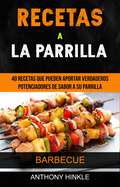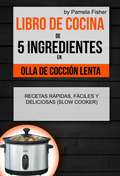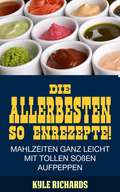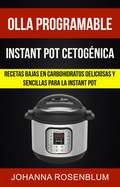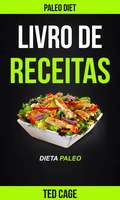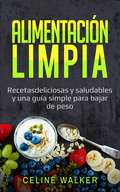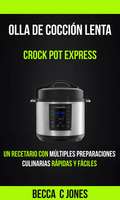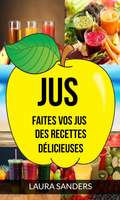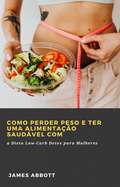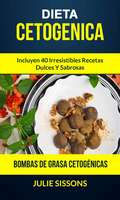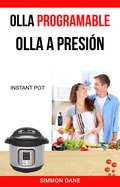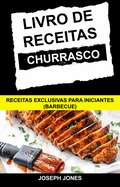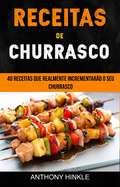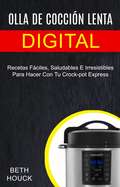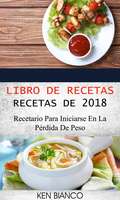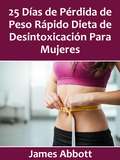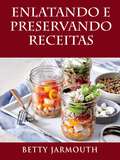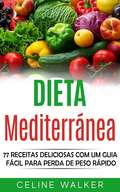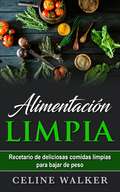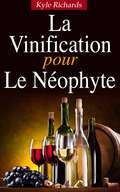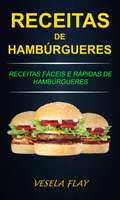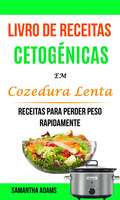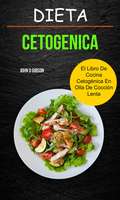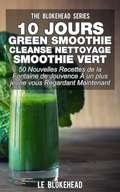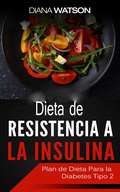- Table View
- List View
Recetas a la parrilla: 40 recetas que pueden aportar verdaderos potenciadores de sabor a su parrilla (Barbecue)
by Anthony Hinkle Gerardo Bravo RodríguezRecetas secretas para los profesionales y amateurs de la parrilla, amantes de lo ahumado y y amantes de asar a la parrilla. ¿Quiere impresionar a su familia y amigos con su talento para asar a la parrilla? No hay nada mejor para un día cálido y soleado que carne asándose lentamente en una parrilla. Reunir a familiares y amigos para convivir en su fiesta magistralmente preparada es uno de los grandes placeres del verano. Ya sea que esté buscando una guía de iniciación, buscando ideas para asar o simplemente tratando de encontrar deliciosas recetas, ¡estará listo para comenzar a asar! “Bueno, ¿ahora qué?” ¡Estas son algunas de las recetas que puede probar! •Las mejores Alitas de pollo ahumadas •Icónicas Munes Japonesas a la BBQ o Pechuga de pollo estilo Yakitori Kebabs •Increíble Salsa BBQ de arándano •Increíbles Salchichas de puerco con cebolla •Exquisitas Faldas de res •Fantásticas Salchichas a la parrilla con cerveza •Estupenda salsa BBQ •Alegre Salsa BBQ ¡Use estas recetas y comience a cocinar hoy! Tiene a su alcance la herramienta que necesita para que se le conozca no solo como el maestro de la parrilla de sus amigos, ¡sino como el “Maestro del sabor”! El libro está lleno de una gran cantidad de información e instrucciones para que pueda mejorar sus recetas de parrilla y barbacoa.
Libro de cocina de 5 ingredientes en olla de cocción lenta: recetas rápidas, fáciles y deliciosas (Slow Cooker)
by Pamela Fisher Andreina Briceño Escobar¿Cansado de comer comida procesada y pedirla fuera? ¿Por qué no dejar que su cocinera lenta haga el trabajo con sólo 5 ingredientes? Disfrute de esta colección de saludables y deliciosas recetas en ollas de cocción Lentas. ¡Elegí todas las recetas más fáciles de mi colección y las puse en un solo libro de cocina para ti! ¡5 Ingredientes o menos! Este libro electrónico contiene información sobre cómo cocinar comidas usando cocinas lentas y diferentes recetas que usan cinco ingredientes o menos. Las recetas son simples y fáciles y son ideales incluso para personas ocupadas como usted. Hay muchas recetas incluidas en este e-libro que usted puede elegir de modo que usted pueda tener una variedad de comidas deliciosas cada semana que parezca que usted pone mucho tiempo y energía en cocinarlas. Estas saludables recetas te ayudarán a satisfacerte con deliciosos platos sin perder el tiempo. Será muy fácil permanecer en el camino todos los días y sorprender a su familia con platos sabrosos e irrepetibles. Todas las recetas en este libro son muy divertidas, deliciosas, saludables y simples recetas.
Die allerbesten Saucenrezepte! Mahlzeiten ganz leicht mit tollen Soßen aufpeppen
by Kyle Richards Beatrice RueckertWollen Sie ein perfektes Mahl für Ihre Familie zubereiten? Dann sollten Sie sich mit den verschiedenen Möglichkeiten, perfekte Soßen herzustellen, auskennen. Eine Soße kann das Aroma und den Geschmack Ihrer Lieblingsgerichte aufwerten. Verwandeln Sie jedes noch so einfache, alltägliche Essen in ein Gourmetgericht. Selbst ein einfaches Gemüsegericht kann so spannend werden. Die allerbesten Saucenrezepte sind hier für Sie! Dieses Buch ist randvoll mit mehr als 150 großartigen Soßenrezepten wie zum Beispiel: · Cocktailsoßen · Bratensoßen · Barbecuesoßen · Fleischsoßen · Dessertsoßen · Soßen mit Schwips · Sirup · Butter · Mayonnaise · Helle Sahnesoßen · Salatdressings In diesem eBook finden Sie : - Wissenswertes zu benötigten Zutaten für Ihre Soßenrezepte - Leicht zu folgende schrittweise Zubereitungsweisen - Varianten zu Ihren Lieblingssoßenrezepten - Eine Vielfalt an Soßenrezepten für Ihre Familie und vieles mehr! Die allerbesten Saucenrezepte ist mit leicht zu folgenden Rezepten ohne teure Zutaten gefüllt. Egal, ob Sie ein einfaches oder ein außergewöhnliches Soßenrezept zubereiten wollen, Sie werden finden, wonach Sie suchen. Kochen Sie gerne einfache Gerichte, die Ihren Verwandten und Bekannten gefallen? Dann ist dieses eBook genau das Richtige für Sie. Dieses Buch mit seinem vielfältigem Inhalt wird Ihnen gefallen und dabei helfen, ein besonderes Menü zu erstellen. Worauf warten Sie? Tolle Gerichte und Soßenrezepte zuzubereiten ist schnell und kinderleicht. Laden Sie sich Ihr Exemlar jetzt herunter.
Olla programable: Recetas bajas en carbohidratos deliciosas y sencillas para la instant pot
by Marissa Aguayo Gavilano Johanna Rosenblum¿Estás lista para eliminar rápidamente la grasa de tu cuerpo y no volver a recuperarla? ¿Quieres deliciosas recetas cetogénicas para toda tu familia que puedes preparar fácilmente en tu instant pot? El libro de cocina Instant pot cetogénica te puede ayudar a conseguir el cuerpo que siempre has deseado con recetas sencillas, sabrosas y nutritivas que te ayudarán a deshacerte de esos kilitos de más. La instant pot u olla a presión programable es el electrodoméstico esencial del siglo XXI. Permite que todos, profesionales, mamás y papás ocupados, y estudiantes universitarios, creen comidas asombrosas en una sola olla. No es lo mismo que la olla de cocción lenta de los viejos tiempos. Estás a punto de descubrir cómo crear más de 40 recetas keto saludables y deliciosas con la instant pot y tendrás a tu alcance todas las instrucciones e información nutricional de cada plato. Todas las recetas conservan las proporciones de macros de la dieta cetogénica y se centran en verduras de bajo índice de insulina, carnes y grasas saludables. Vista previa de algunas recetas: •Única sopa de espárragos •Magnífico guiso de pollo y salchichas •Deliciosa sopa vegetariana •Legendario y cremoso pollo con brócoli •Sabrosa sopa de repollo y zanahoria •Impresionante cerdo kalua •Estofado de pollo titánico •Rápidas chuletas de cerdo con zanahoria •Guiso de pavo riquísimo •Maravillosas costillas de ternera La Instant pot cetogénica te ayudará a lograr una pérdida de peso duradera, revertir la resistencia a la insulina y evitar tener una vida plagada de enfermedades, como la obesidad, la resistencia metabólica y las enfermedades cardíacas. Tendrás más energía y poder cognitivo que nunca sin necesidad de sentir hambre o privaciones. ¡Adquiere este libro para explorar e
Livro de receitas Dieta Paleo (Paleo Diet)
by Ted Cage Rafael GaspariniA dieta Paleo pode te ajudar a decifrar quais alimentos são mais saudáveis para você e pode encurtar o seu tempo de compras eliminando as comidas processadas. Se alimentarde forma mais saudável e perder peso já são razões suficientes para testar a dieta paleo, mas tem um benefício adicional que vai além da perda de peso.
Alimentación limpia: Recetas deliciosas y saludables y una guía simple para bajar de peso
by Celine WalkerEs fácil que quienes recién se inician en el mundo de la alimentación limpia piensen que solo es otra dieta más que se ha puesto de moda. Sin embargo, la alimentación limpia es un estilo de vida, ya que se trata de modificar tanto la forma en que comes como los alimentos que consumes y no de restringir la cantidad de comida que ingresa a tu cuerpo. Comer limpio significa elegir alimentos integrales y desechar los procesados. Se trata de eliminar los carbohidratos, azúcares y grasas innecesarias de la dieta para comer más sano (y perder peso en el camino). Seguir una dieta limpia también significa eliminar la comida chatarra. Así que: rechaza aquellas comidas que no ofrecen a tu cuerpo ningún valor nutricional, como los alimentos refinados, con alto contenido de grasas saturadas y sal, alimentos procesados y cargados de azúcares y saborizantes artificiales. Por último, la alimentación limpia significa nutrir a tu cuerpo con frutas y verduras, grasas saludables, cereales no refinados y proteínas magras. Tu cuerpo te lo agradecerá porque estos alimentos te proporcionarán muchos beneficios y mejorarán tu salud. En este libro, descubrirás: · La esencia de la alimentación limpia · Ocho pasos para comer "limpio" · Consejos y trucos para tener una alimentación limpia · Desayunos limpios para acelerar tu metabolismo · Almuerzos limpios para estabilizar tu nivel de azúcar en la sangre · Cenas limpias para mantener tus niveles de energía · Bocadillos limpios que evitarán que asaltes la despensa · ¡Y mucho más! ¡Adquiere el libro ahora para aprender más sobre la alimentación limpia!
Olla De Cocción Lenta: Un Recetario con múltiples preparaciones culinarias rápidas y fáciles
by Becca C Jones Ricardo Perez UribeEste libro de recetas contiene una amplia variedad de recetas sencillas y deliciosas de preparar con su Crock Pot® Express en su olla multiuso Crock Pot® Express, y te proporcionará toda la información acerca de cómo aprovechar al máximo tu olla a presión Crock Pot® Express. Crock Pot® presenta varias de sus útiles funciones. Viene con 8 configuraciones para cocción a presión como carne, arroz, estofado, frijoles, chile, etc., lo que te ahorrará mucho tiempo y esfuerzo. No solo esto, los cuatro modos importantes que incluyen la cocción lenta, cocción a presión, saltear / dorado o a vapor. Express Crock Pot® es el ayudante para tu cocina más valiosa. Explica paso a paso como la Express Crock Pot® cocina tu preparaciones un 70% más rápido que las comidas corrientes, ahorra mucho tiempo en la cocina. En este libro, encontrarás varias recetas que incluyen desayunos, carne de res y cordero, carne de ave, cerdo, mariscos y verduras. En el interior encontrarás: Capítulo 1: Introducción Capítulo 2: Consejos para principiantes Capítulo 3: Fantásticos Consejos para usar The Crock Pot® Express Capítulo 4: ¿Cuáles son las ventajas de un Multi-Cooker™? Capítulo 5: Recetas Este libro de recetas es sumamente fácil de usar y te ayudará a encontrar la receta apropiada para satisfacer tus antojos. El libro ha agrupado las recetas en varios capítulos para facilitarte su búsqueda. Mientras preparas estas recetas además de ahorrar tiempo, puedes disfrutar con tu familia y amigos de las unas verdaderas delicias.
Jus: des recettes délicieuses
by Laura Sanders Julien GaichetDes recettes de jus incroyables! Vous pensez que vous n'avez pas assez de temps pour préparer des collations ou des plats qui soient sains et délicieux ? Aimeriez-vous avoir plus d'énergie, être plus heureux et vous sentir en meilleure santé chaque jour ? Aimeriez-vous recevoir de nombreuses idées de recettes délicieuses, rapides et faciles ? Si vous avez répondu "oui" à l'une des questions ci-dessus, alors ce livre est pour vous ! Ce livre est le moyen le plus simple et le plus rapide de transformer votre vie. Des recettes de jus à base de fruits et de légumes riches en vitamines peuvent vous aider à perdre du poids et à améliorer votre santé en stimulant votre métabolisme et en nettoyant votre corps. UN BONUS SPÉCIAL SE TROUVE À L'INTÉRIEUR POUR TOUS LES LECTEURS ! Le principal avantage de faire vos jus est le fait que vous consommez plus de fruits et de légumes. Dans une société où nous vivons une vie transformée, il peut sembler difficile de consommer suffisamment de nourriture saine, et les jus de fruits permettent d'y remedier. Associez vos jus à un mode de vie sain pour avoir une santé optimale et un corps dans lequel vous aimez vivre la vie.
Como Perder Peso e Ter uma Alimentação Saudável com a Dieta Low-Carb Detox para Mulheres
by James Abbott Paulo Molina SalesUm guia saudável e detalhado para ajudar você a entender como eliminar gordura corporal naturalmente, em 25 dias ou menos . Esse guia irá te ajudar a aproveitar a capacidade natural do seu corpo para queimar gordura e entrar em forma. Baseado em ciência sólida e comprovada, este livro vai te ensinar: - Esconder o apetite - Melhores hábitos para perder peso - Melhores alimentos para perder peso - Melhores treinos para perder peso - Aumentar sua energia e metabolismo Se você quer ter mais energia enquanto perde peso, então esse livro é para você.
Dieta cetogenica: Incluyen 40 irresistibles recetas dulces y sabrosas.
by Julie Sissons¡Quema grasa, pierde peso e incrementa tus niveles de energía con estas deliciosas y nutritivas bombas de grasa Cetogénicas! ¡La dieta Cetogénica es la forma más rápida de perder peso garantizado! ¿Te apetece un bocadillo entre comidas pero no estás seguro de cuan saludables es? Este libro, resolverá ese problema. Las bombas de grasa normalmente están hechas con una serie de ingredientes que permiten el aumento de energía al instante. Las grasas no se almacenan, ya que estas se usan instantáneamente para crear energía. Son ricas en nutrientes, las bombas de grasa son geniales cuando necesitas un golpe instantáneo de energía. Estos sabrosos aperitivos, están llenos de sabor y te ayudaran en el día. Son perfectos como merienda antes o después del entrenamiento. Estos fueron ideados originalmente para ayudar a las personas con una dieta baja en carbohidratos o Cetogénica, como merienda para ayudar durante el día. Ya que están llenos de grasa y proteínas, los carbohidratos están prácticamente ausentes, son perfectos para cualquiera. Todas las recetas: Pruebe cada bocado tan bueno como los postres de alto contenido de azúcar que extraña, lo que significa que puede satisfacer sus antojos, pero permaneciendo en la dieta Cetogénica y continuar quemando grasa. Sera amado por toda su familia, no más hacer postres diferentes para la familia. Son fáciles de hacer, de preparar y los ingredientes son fáciles de conseguir. Usa tu tiempo libre en cosas que realmente amas, no buscando ingredientes costosos y pasando horas en la cocina. ¡Entonces comencemos a bajar peso de inmediato! ¡Disfruta de estas fantásticas bombas de grasa como un postre cetogenico o un aperitivo de energía! ¡Compre el libro a su precio MAS BAJO!
Olla programable: Olla a presión (Instant Pot)
by Simmon Dane María del Pilar Verón¿Cuán a menudo te encuentras a ti mismo buscando nuevas e interesantes recetas para preparar a tus seres queridos? ¿Quieres tener una revista de cocina a mano para que te provea de recetas asombrosas y magnificas para tus seres queridos? Una nueva tendencia entre la gente que come sano es disfrutar de cocinar con el mínimo desastre y el tiempo es en la olla a presión. Es una cocina a presión eléctrica moderna que se puede usar como una cocina lenta , una estufa, una vaporera y como una sartén. Utilizando una olla a presión puede reducir el tiempo de cocina al 70%. No es necesario pasar horas en la cocina, permanecer frente a muchas ollas y sartenes. ¿Estas buscando recetas fáciles para tu olla? Estás cansado de ver recetas que te dejan con el exceso de las sobras? ¿Quieres recetas deliciosas que se puedan hacer rápido para que encaje en tu estilo de vida? Perfecto para cualquier momento del día, este libro le mostrará que la olla a presión no es un aparato hecho para familias numerosas solamente. También es ideal para dos barrigas hambrientas.
Livro de Receitas Churrasco: Receitas Exclusivas Para Iniciantes (Barbecue)
by Camila Domingues Joseph JonesVocê quer impressionar sua família e seus convidados com suas habilidades de churrasqueiro? Algumas receitas que você irá encontrar nesse livro são: •Churrasco com Molho Chili •Manteiga de Maçã Charmosa e Molho para Churrasco de Whisky Fireball •Beef Brisket com Budweiser •Molho para Churrasco de Whisky •Deliciosos Tacos com Bife •Molho Guardhouse Surpreendente •Molho Guardhouse Excelente •E muito mais... Receita de churrasco simples está em alta devido o desejo das pessoas em comer de forma mais saldável e ter mais praticidade na hora de fazer seus churrascos. Isso é exatamente o que esse livro leva à mesa: a chance de você apreciar um churrasco feito por você mesmo num estalar de dedos. Então, da próxima vez que você tiver uma festa ou uma reunião... ... esteja certo de pegar uma das minhas 35 receitas favoritas para churrasco, mexer com a mente de seus convidados e fazer com que eles queiram mais.
Receitas de Churrasco: 40 Receitas Que Realmente Incrementarão o Seu Churrasco
by Anthony HinkleReceitas secretas para os entusiastas e profissionais em grelhas, defumação e churrasco. Você quer impressionar seus familiares e convidados com suas habilidades para churrasco? Não há nada melhor, numa tarde quente e ensolarada, do que uma carne assada vagarosamente na churrasqueira. Reunir amigos e familiares para compartilhar um verdadeiro banquete é um dos melhores prazeres do verão. Se você está procurando um guia prático, pesquisando sobre ideias para defumação, ou apenas tentando encontrar receitas que dão água na boca, vou está pronto para iniciar um CHURRASCO! “Certo, huuum, e agora?? Aqui Têm Algumas Receitas Para Experimentar! •Peito de Frango Exclusivo e Delicioso •Espetinhos Icônicos Yakitori de Frango •Maravilhoso Molho de Churrasco com Mirtilo •Super Linguiça de Porco com Cebolas •Beef Brisket Encantador •Fantásticas Linguiças Brats com Cerveja •Molho de Churrasco Maravilhoso •Molho de Churrasco Feliz Use essas receitas e comece a cozinhar hoje! Você tem em suas mãos a ferramenta que você precisa para ser conhecido não só como o master chef do churrasco em seu grupo, mas também como o senhor dos sabores! Acompanha uma riqueza de informações e instruções para você aprimorar suas receitas de churrasco e grelha.
Olla de cocción lenta digital: Recetas Fáciles, Saludables E Irresistibles Para Hacer Con Tu Crock-pot Express
by Beth Houck María Agostina MussoSi piensas llevar un estilo de vida saludable y dinámico, una olla a presión eléctrica es el utensilio de cocina que necesitas. La Crock-Pot Express es una olla con múltiples funciones que cuenta con tecnología one-touch y reguladores de temperatura y presión, para cocinar tus platos de manera saludable mientras ahorras tiempo y dinero. Las olla de cocción lenta han sido de gran ventaja para cocinar por generaciones, a la vez que han ayudado a elaborar comidas increíbles. Sin embargo, muchas personas eligen la opción de cocción rápida, y por eso es que las ollas con tecnología digital han sido vendidas de manera masiva. Con la Crock-Pot Express Multi-Cooker puedes preparar cualquier tipo de plato y elegir la opción de cocción lenta o rápida.
Libro de recetas: Recetario para iniciarse en la pérdida de peso
by Ken BiancoEste libro contiene pasos y estrategias probados para perder peso rápidamente; ¡cambia tu vida ahora y vive más y mejor! En este libro, encontrarás: •Capítulo 1: ¿Por qué elegir Weight Watchers? •Capítulo 2: ¿Qué son los Puntos Inteligentes? •Capítulo 3: Puntos Inteligentes •Capítulo 4: ¿Qué alimentos puedo comer? •Capítulo 5: Los alimentos con Puntos Inteligentes más comunes •Capítulo 6: Mantener la motivación •Capítulo 7: Recetas Lo que es genial es que el nuevo plan de Estilo Libre cuenta con nuevos agregados a la lista de alimentos con puntaje cero, lo que te permite tener más opciones. Este libro está repleto de recetas para que puedas comenzar tu nuevo plan de salud o para mejorar tu menú. No te pierdas este libro con comidas deliciosas y rápidas de hacer; ¡obtén tu ejemplar ahora!
25 Días de Pérdida de Peso Rápido Dieta de Desintoxicación Para Mujeres
by James Abbott Mirna GarcíaUna guía detallada y saludable para comprender y eliminar la grasa corporal de forma natural en 25 días o menos. Esta guía te ayudará a aprovechar la capacidad natural de tu cuerpo para quemar grasa y ponerte en forma. Basado en ciencia sólida y probada, este libro le enseñará cómo: - Suprime el apetito - Los mejores hábitos para perder peso - Las mejores comidas para perder peso - Mejores entrenamientos para bajar de peso - Mejora tu energía y tu metabolismo
Enlatando e Preservando Receitas
by Beatriz dos Santos Maranho Betty JarmouthUm Guia Passo a Passo em Como Enlatar e Preservar Comida - Suprimentos Necessários - A mecânica e Como se Preparar -Como Enlatar e Preservar Comida em Potes Com Sucesso Aviso: A autora e/ou donos dos diretos autorais, não fazem afirmações, promessas ou garantem a precisão, completude, ou adequação dos conteúdos desse livro e expressamente se isenta da responsabilidades por erros e omissões no conteúdo. Este produto é apenas para referência.
Dieta mediterránea: 77 Receitas Deliciosas com um Guia Fácil Para Perda de Peso Rápido
by Celine Walker Cecília CalheirosEste livro contém receitas simples e fáceis que incorporam elementos básicos da dieta Mediterrânea. Estas receitas incluem vários ingredientes frescos que contém antioxidantes, minerais, vitaminas, gorduras saudáveis, e todos eles promovem saúde. Estes ingredientes auxiliam a restaurar seu corpo e a acelerar o seu metabolismo, para queimar as gorduras em excesso. Perder peso não se trata de passar fome e suar por horas na academia.
Alimentación limpia: Recetario de deliciosas comidas limpias para bajar de peso
by Celine Walker Marissa Aguayo GavilanoDescubre las recetas limpias más deliciosas para mantener una vida sana y perder peso Comer comida chatarra o procesada puede afectar negativamente tu cuerpo y mente. Cuando no comes limpio, tu mente no funcionará a un nivel óptimo, ya que perderás la concentración y te sentirás cansado. Además, tu cuerpo se volverá cada vez más lento, ya que tu dieta está llena de químicos y carece de nutrientes. Pero no te debes preocupar, porque este libro te ayudará a empezar a comer alimentos naturales llenos de nutrientes. Este libro cambiará la forma en que ves a la comida. Descubrirás cómo elegir los alimentos que son beneficiosos para tu salud y que te ayudarán a bajar de peso. Además, aprenderás a disfrutar de una buena y sabrosa comida sin sentirte privado o culpable por ello. Este libro te dará consejos sobre cómo comprar y preparar los alimentos de una manera "limpia". Verás que seguir las recetas de este libro es fácil y divertido porque no tendrás que matarte de hambre ni sacrificar ciertos grupos alimenticios. Este libro también te ayudará a adaptarte a un estilo de vida saludable que te permite disfrutar de alimentos naturales, nutritivos y sabrosos. En este libro, descubrirás: · La verdad sobre la alimentación limpia que te ayudará a mantener tu figura · Desayunos limpios para perder peso · Almuerzos limpios para adelgazar · Cenas limpias para eliminar kilos de más · ¡Y mucho más! ¡Adquiere el libro ahora para aprender más sobre la alimentación limpia!
La Vinification pour le Neophyte
by Kyle Richards Nathalie MalapelleSi vous êtes un amateur de vin ou un siroteur occasionnel de week-end, « La vinification pour le Néophyte » est le guide idéal pour mettre la fierté et le plaisir de la vinification entre vos mains ! Ne vous laissez pas intimidé par les acres de raisins et de granges d'équipement lourd dans les vignobles, vous pouvez faire du vin délicieux à la maison, et ce e-book vous montre comment ! Pas besoin d'expérience, nous avons divisé le processus en étapes simples pour que chacun puisse faire de délicieux vins parfumés chez vous et avec plaisir ! A Partager avec votre famille et vos amis ou conservez-le pour des occasions spéciales. Il est si gratifiant d’offrir en cadeau une bouteille de vin que vous avez fabriqué à un ami ou à un être cher. Certaines questions communes des personnes qui n'ont jamais fabriquées de vin avant sont : · Quelle sorte de raisin devrais-je utiliser ? · De quel équipement ai-je besoin ? · Quel est le coût de cet équipement ? · Est-ce difficile de fabriquer du vin a la maison ? · De quoi est fait le vin ? Ce livre électronique aborde ces questions et plus encore. Avec notre mode d’emploi facile, votre nom sera bientôt sur l’étiquette de votre vin préféré ! Plus besoin de rester figer devant les étagères sans fins remplies de vins mystérieux hors de prix au magasin. « La vinification pour le Néophyte » fera en sorte que vous puissiez commencer à faire du vin en un rien de temps ! La vinification pour le Néophyte
Receitas de Hambúrgueres: Receitas Fáceis e Rápidas de Hambúrgueres
by Vesela Flay Larissa Milani De SouzaHambúrgueres são verdadeiramente maravilhosos. Eles podem ser salgados, ácidos, doces e podem trazer à tona o melhor sabor de qualquer carne. Não há dúvidas do porquê hambúrgueres são tão populares. Hambúrgueres são frequentemente apresentados com queijo cheddar, alface, tomate, bacon, cebola, pepino em conserva e guarnições, como por exemplo, mostarda, maionese, catchup, vinagrete e pimentas. A expressão hambúrguer pode ser associada à carne sozinha, particularmente no Reino Unido, onde a expressão é usada de vez em quanto. Algumas receitassão excelentes para as crianças tentarem também. De amantes de carne à vegetarianos, haverá um hambúrguer neste livro para você! Vamos cozinhar! Não perca tempo e adquira sua cópia hoje mesmo!
Livro de Receitas Cetogénicas Em Cozedura Lenta: Receitas Para Perder Peso Rapidamente
by Samantha Adams Ana RomaFantásticas Receitas Cetogénicas Em Cozedura Lenta. A melhor coleção de receitas de dieta cetogénica para panelas de cozedura lenta. Diga adeus à gordura e abraçe as novas mudanças no seu corpo. Perder peso não tem que ser difícil e com o Livro de Receitas Cetogénicas Em Cozedura Lenta pode fazer com que seja mais fácil ao eliminar qualque hipótese de falha. Atingir o estado cetónico é fácil. Tudo o que precisa é de limitar a ingestão de hidratos de carbono a não mais do que 15 gramas por dia. Apesar de parecer extremo a introdução da utilização da panela de cozedura lenta na rotina diária irá simplificar o processo. É por isso que este livro de receitas inclui uma vasta gama de receitas, desde pequeno-almoço, entradas, carne de porco, vaca, aves, peixe e sopas para certificar que tenha à mão uma receita cetónica pronta para satisfazer os seus desejos. O que irá encontrar no livro? •Capítulo 1 – Introdução à Panela de Cozedura Lenta Cetogénica •Capítulo 2 – Começar Uma Dieta Cetogénica: Tudo O Que Precisa de Saber •Capítulo 3 – Tipos de Panelas de Cozedura Lenta Disponíveis •Capítulo 4 – Dicas Importantes a Relembrar •Capítulo 5 - Receitas Compre já e disfrute de receitas deliciosas enquanto perde peso.
Dieta cetogenica: El Libro de Cocina Cetogénica en Olla de Cocción Lenta
by John GibsonDeliciosas Recetas Ceto Para Perder Peso por: John D Gibson ¿Estas siguiendo una dieta cetogénica o estas planeando hacerlo en un futuro cercano? Le preocupa que comida puede comer y como mantenerlo interesante? Comer una dieta alta en grasa para perder peso suena demasiado para ser verdad, sin embargo, la dieta cetogénica ofrece exactamente eso. Pero para realmente tener éxito en la dieta cetogénica, necesitas recetas que no solo son simples, pero que realmente funcionaran. Usando la dieta cetogénica, podrás aumentar tus niveles de energía al tope, mientras restauras tu metabolismo, tu salud y perder peso en el proceso. Las dietas cetogénicas utilizan alimentos bajos en carbohidratos y altos en grasa, en combinación con los métodos de cocción lenta, lo cual permite que tu cuerpo alcance su máximo potencial, y alcanzar el máximo grado de salud a la fecha. Porque deberías comprar este libro: No hay ingredientes complicados de los que no hayas escuchado No son necesarios instrumentos de cocina complicados (olla de cocción lenta, licuadora de mano y procesador de alimentos harán todas las recetas que se proporcionan en ese libro de recetas. Utiliza instrucciones simples, cortas y fáciles de seguir. Recetas Orientadas 100% a la dieta ceto (Compatible con dieta cetogénica, LCHF) La mejor colección de recetas de cocción lenta cetogénicas, todo se cocina a la perfección. Di adiós a tu grasa para siempre, y disfruta los nuevos cambios en tu cuerpo.
10 Jours Green Smoothie Cleanse Nettoyage Smoothie Vert: 50 Nouvelles Recettes de la Fontaine de Jouvence À un Plus Jeune Vous Regardant Maintenant (The Blokehead Series)
by Jodie Sloan Erick Bolivar Sanchez Rosario10 jours de nettoyage vert Smoothie Cleanse : 50 nouvelles recettes de la fontaine de jouvence à un jeune qui vous regarde maintenant. Jus de pomme et de myrtille : Ingrédients : Bleuets - 2 tasses Pommes - 2 Méthode : Laver à fond et enlever les graines des fruits. Mettez-les dans un mixeur et faites un jus. Ajoutez de la glace et savourez cette boisson savoureuse. Buvez le jus immédiatement après la préparation. Jus de pomme et de myrtille : Ingrédients : Bleuets - 2 tasses Pommes - 2 Méthode : Laver à fond et enlever les graines des fruits. Mettez-les dans un mixeur et faites un jus. Ajoutez de la glace et savourez cette boisson savoureuse. Buvez le jus immédiatement après la préparation ; il prendra la texture d'un gel après une demi-heure de préparation. Prenez le livre pour plus de recettes de smoothies maintenant !
Dieta De Resistencia A La Insulina: Plan de Dieta Para La Diabetes Tipo 2
by Diana WatsonQuem disse que você tem que abrir mão dos seus pratos favoritos? A diabetes tipo 2 pode ser controlada através do preparo de receitas deliciosas com alto teor de proteínas e baixo teor de açúcares! Você tem diabetes tipo 2? Tem dificuldades para controlar a sua glicemia no dia a dia? Os seus níveis de açúcar no sangue sobem depois de uma refeição pesada, obrigando você a tomar algum medicamento para estabilizar este problema? E o mais importante, você está procurando uma dieta confiável que mantém os seus níveis glicêmicos estáveis após cada refeição e que seja saborosa e sacie a sua fome? Aqui está o livro ‘Plano Alimentar de Resistência à Insulina para Diabéticos Tipo 2’ – ‘Coma o que quiser e controle a sua diabetes ao mesmo tempo’. Este livro contém as seguintes informações: O que a dieta para resistência à insulina pode fazer por você Como ela funciona e controla este problema em longo prazo Um plano alimentar completo para você iniciar Expectativas e metas que você deve estabelecer Receitas saudáveis com baixo teor de açúcar para o café da manhã, almoço e jantar Refeições para você ter mais saúde e um corpo mais sadio Aqui estão algumas receitas que você vai amar: Frittata de Tomate e Manjericão Muffins de Banana com Cenoura e Noz-Pecã Mexido de Legumes com Queijo de Cabra Homus Cítrico Tabule de Quinoa Espetinhos de Camarão Grelhado Pimentões Recheados com Carne Moída e Arroz Hambúrguer de Peru Grelhado Peito de Frango com Molho de Laranja Patê de Camarão com Estragão e Mostarda, e muito mais... Compre este livro hoje e, definitivamente, diga adeus àquelas comidas sem graça. Clique no botão “Compre Agora” para receber sua cópia!
